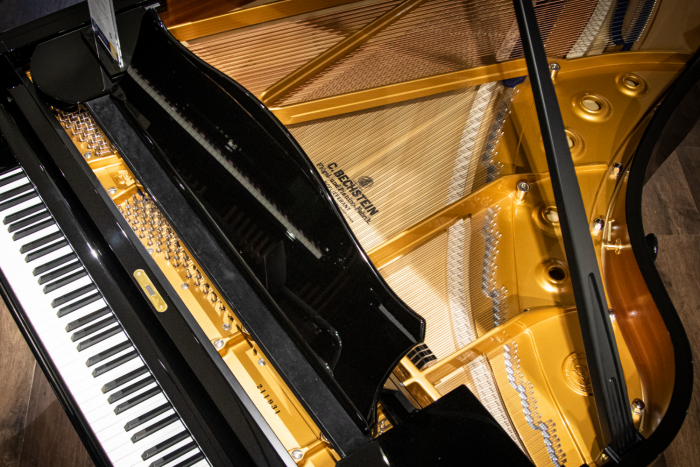Digital pianos are expensive due to advanced technology and high-quality materials. The cost reflects the effort to emulate the sound and feel of an acoustic piano.
Owning a digital piano is an investment in musical expression, combining the majesty of traditional pianos with modern-day advancements. These sophisticated instruments use intricate sampling techniques and weighted key mechanisms to deliver an authentic piano-playing experience. Manufacturers invest heavily in research and development to ensure that every nuance and dynamic of piano sound is captured, resulting in higher production costs.
The durability and versatility of digital pianos also contribute to their cost. They offer features like volume control, headphone outputs, and diverse instrument voices that require complex electronic components. This attention to detail and added functionality makes digital pianos a valuable tool for both beginners and professional musicians, despite the higher price tag.
The Rise Of Digital Pianos
As technology advances, so does the world of music. Digital pianos represent a significant leap, blending the charm of traditional pianos with today’s innovation. Costs climb due to the sophistication involved in creating these modern instruments. They deliver sound and feel akin to acoustic pianos without the size and tuning needs.
Transforming Traditional Music
Digital pianos have revolutionized music in several ways:
- Variety of Features: They come with diverse sounds and effects, adding depth to musical pieces.
- Recording Capabilities: Musicians can record and playback their performances, an invaluable tool for learning.
- Connectivity: These pianos connect to computers and apps, opening a world of learning and sharing possibilities.
These transformations make digital pianos appealing but also contribute to their higher cost.
Market Growth And Consumer Demand
Global fascination with digital pianos is soaring. Here’s what’s driving the market:
| Trend | Impact on Cost |
|---|---|
| Increased Interest | As more people want digital pianos, research and development costs are spread over more units, theoretically reducing individual costs. Yet, high demand keeps prices up. |
| Quality Expectations | Buyers expect exceptional sound and keys that mimic an acoustic piano. Higher manufacturing standards lead to increased prices. |
Digital pianos mirror the touch, feel, and sound of their grand predecessors. They cater to professional and at-home settings. User-friendly features and growing demand keep these instruments at the forefront of technological convergence and music evolution, which justifies their expense.
Components Driving The Cost
If you’ve ever wondered why digital pianos can carry a high price tag, the answer lies within their complex build and features. Each component, from the keys to the sound system, plays a critical role in creating an authentic piano experience. Let’s dive into the specific elements that contribute to the cost of these musical marvels.
Weighted Keys And Action Mechanisms
One of the main factors that sets high-quality digital pianos apart is their weighted key mechanism. The sensation of playing on a traditional acoustic piano comes from the resistance of each key press. Manufacturers incorporate sophisticated action mechanisms to replicate this feel.
These systems often include actual hammers and complex leverage components, which simulate the heft and response of acoustic piano keys. With this technology, pianists can expect a dynamic range of touch and velocity, essential for expressive performance.
Advanced Sound Technology
The heart of a digital piano’s magic is its ability to produce rich, versatile sounds. Manufacturers use advanced technology to capture the nuances of acoustic piano tones.
This process involves recording high-end grand pianos in professional settings, creating a sound library that’s realistic and immersive. The result is a digital piano that can sound indistinguishable from its traditional counterpart.
Quality Speakers And Amplification
Without a resonant chamber like an acoustic piano, digital pianos rely on built-in speakers and amplifiers to project their sound. High-quality components in this department are crucial for clear, powerful audio that fills the room.
These speakers and amplifiers must be precisely calibrated to work with the piano’s sound engine, ensuring they deliver audio true to the original recordings.
Sophisticated Sampling And Software
At the core of a digital piano’s sound reproduction is the software that powers it. Meticulously sampled notes from every key at various velocities provide the lifelike sound.
Along with these samples, software algorithms add reverberations, resonance, and other acoustic phenomena that give the piano its character. This combination of high-fidelity sampling and cutting-edge software contributes significantly to the digital piano’s cost.
Manufacturing And Materials
The craftsmanship behind the creation of digital pianos is a tale of innovation and quality. Manufacturers invest considerably in both materials and technology to ensure these musical instruments not only sound superb but also endure the test of time. Let’s plunge into the world of Manufacturing and Materials to understand the hefty price tag.
Durable Construction Elements
Key to a digital piano’s longevity is its robust construction. Brands like Yamaha and Roland use hard-wearing materials to replicate the heft and stability of acoustic pianos. Frames crafted from metals and advanced composites offer strength, while high-quality plastics and wood veneers provide a pleasing aesthetic without sacrificing durability. This ensures that the piano can withstand years of practicing and performing.
Precision Engineering
Instruments must mirror the delicate nuances of an acoustic piano. To achieve this, precision engineering is paramount. Digital pianos feature complex hammer action systems, weighted keys, and fine-tuned circuitry. Such meticulous craftsmanship seeks perfection, contributing to higher production costs.
Costs Of Material Sourcing
- Ethical procurement ensures materials are sourced responsibly.
- High-grade electronic components like chips and processors are essential.
- The quality wood used for keys and detailing calls for careful selection.
- Specialized plastics and metals must meet strict standards for durability.
These factors lead to an increase in the overall cost of materials, directly impacting the selling price of digital pianos. Unique textures, colors, and materials customized for higher-end models also add to the expense. Hence, when you purchase a digital piano, you are also paying for the fine materials and responsible sourcing methods employed.
The Impact Of Brand Reputation
The Impact of Brand Reputation on the price of digital pianos cannot be overstated. Renowned brands garner respect and a higher perceived value. This often culminates in hefty price tags. Let’s unravel why brand influence plays a critical role in the cost of these musical instruments.
Prestigious Manufacturers
Prestigious piano brands have histories of quality and craftsmanship. Names like Yamaha, Roland, and Kawai carry weight in the music world. These manufacturers invest in research, materials, and skilled labor. Their pianos bring innovative features and exceptional sound quality. Consequently, their instruments command premium prices. Reputation and heritage factor into every sale.
The Premium Of Brand Loyalty
Brand loyalty significantly affects a digital piano’s price. Consumers trust established brands. They are willing to pay more for this trust. This loyalty stems from years of positive experiences and the promise of consistent quality. The cost reflects not just the instrument, but also the service, warranty, and support that comes with the brand name.
Crafting a table to summarize brand impact:
| Factor | Role in Pricing |
|---|---|
| Historical Value | Increases perceived worth. |
| Innovation | Drives up development costs. |
| Quality Assurance | Justifies higher pricing tiers. |
| Customer Service | Enriches the overall package. |
| Brand Loyalty | Underpins consumer trust and consistent sales. |
Innovation And Features
Innovation and features play pivotal roles in setting digital pianos apart from their acoustic counterparts. Curious why these instruments command such prices? It’s the technology and development invested in them. From the nuanced feel of the keys to the sophisticated sound engines, digital pianos offer an experience that often goes beyond traditional pianos. Let’s dive into the exciting enhancements that contribute to their cost.
Connectivity Options
Modern digital pianos extend their functionality with diverse connectivity options. Look for:
- USB ports for interfacing with computers
- MIDI capabilities for music production
- Bluetooth for wireless audio and data transfer
These features allow musicians to expand their creative horizons in ways acoustic pianos can’t.
Learning Tools And Modes
Digital pianos offer innovative learning tools and modes to aid in musical education:
| Feature | Description |
|---|---|
| Built-in metronome | Keeps players in time |
| Lesson modes | Facilitates hands-on learning |
| Recording function | Allows playback for review |
Students can practice effectively with the piano as a tutor.
Integration With Digital Ecosystems
Integration with digital ecosystems means digital pianos can be part of a larger setup:
- Sync with apps for interactive learning experiences
- Integrate with recording software for professional output
- Connect to online music libraries for unlimited scores
Artists can effortlessly weave their digital piano into a suite of applications for production or enjoyment.

Credit: millersmusic.co.uk
The Long-term Value Proposition
Understanding the cost of digital pianos involves looking beyond the initial price tag. These modern instruments offer significant value over time. Uncover the advantages of investing in a digital piano through its lifespan, resale considerations, and maintenance savings.
Lifespan And Durability Compared To Acoustic Pianos
Digital pianos boast impressive durability, designed to withstand consistent use. They contain fewer mechanical parts than acoustic pianos, which means less wear and tear. This contributes to a longer lifespan without the decline in performance typically associated with aging acoustic pianos.
| Feature | Acoustic Piano | Digital Piano |
|---|---|---|
| Parts | Thousands of mechanical parts | Fewer mechanical parts |
| Maintenance | Regular tuning & repairs | Minimal maintenance |
| Lifespan | 50+ years with maintenance | Up to 20+ years |
Resale Value And Demand
Digital pianos maintain strong resale values partly due to their longevity and the constant demand. Advanced models stay relevant for years, attracting buyers seeking quality at a reduced cost.
- Popular models retain significant value.
- Technology appeals to modern musicians.
- Easier to transport increases saleability.
Cumulative Savings On Maintenance
Money saved on upkeeps reinforces the digital piano’s value proposition. Unlike acoustic pianos, which require tuning, climate control, and potential string or hammer replacements, digital pianos mostly need occasional software updates and general cleaning.
- No regular tuning required.
- Limited environmental sensitivity.
- Lower repair expenses.

Credit: joshuarosspiano.com
Frequently Asked Questions On Why Are Digital Pianos So Expensive
Are Digital Pianos Worth It?
Digital pianos are a valuable investment for budget-conscious musicians and learners, offering portability, variety in sounds, and maintenance-free convenience. They emulate acoustic pianos well, suiting practice and performance needs.
How Much Should A Digital Piano Cost?
Digital pianos vary in price from around $200 for entry-level models to over $2000 for professional instruments.
What Is The Lifespan Of A Digital Piano?
The lifespan of a digital piano typically ranges from 20 to 50 years. Regular maintenance and careful use can help extend its longevity.
Is It A Good Idea To Buy A Used Digital Piano?
Buying a used digital piano can be cost-effective, provided it’s in good condition. Ensure you test the piano’s functionality and check for any wear before purchasing.
Conclusion
Understanding the high costs of digital pianos boils down to recognizing their advanced technology, craftsmanship, and enduring quality. These instruments embody a fusion of artistry and engineering, justifying the investment for passionate musicians. Reflect on the value they bring to your musical journey before deciding on your purchase.
